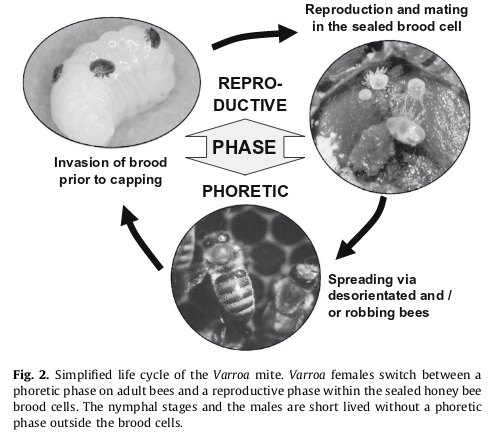Table of Contents
Group 9
<html><font size=6 face=“Arial”>Run for your hives - Can swarming save bees from parasites? </font></html>
Wiki site of the practical exercise of the VIII Southern-Summer School on Mathematical Biology.
Here you will find the exercise assignment and the group's products.
If you are a group member login to edit this page, create new pages from it, and upload files.
Introduction

The mite Varroa destructor is the most important parasite of honey bees and a key threat for apiculture worldwide. These mites are obligatory ectoparasites that breed exclusively inside the capped cells of bee hives where bees care for their larvae. Once within the cell the mites eat the food that nurse bees leave for the larvae and also larvae fluids. Adult mites emerge from these cells and crawl on other bees in the colony, that spread them over the colony and can also carry the mites outside.
The attack by V. destructor is highly lethal, because of its direct consumption of the food and fluids of the larvae and also because the mite is a vector of other pathogens, like the Deformed Wing Virus (DWV). In many temperate regions, human-kept beehives infested by V. destructor collapse in 3-4 years if left untreated.
Nevertheless, honey bee colonies in the wild endure the infestations in many parts of the world. One of the hypothesis for such tolerance is swarming, a natural split of the colony, when at least one queen and part of the worker bees leave the nest and move to set a new colony elsewhere. The number of worker bees thus drops in the original colony, and so do the number of infested adults and the production of larvae. The same occurs with the swarm, that must first find a new nesting site and settle the colony before starting producing larvae. As the mites breed only on larvae, swarming might be an effective way to slow down or even halt the parasite life cycle (Loftus et al. 2016, Diao & Hou 2018). Human management of beehives precludes swarms, which also make these colonies larger than those in the wild.
Assignment
Propose a simple but well-grounded model for the spread of Varroa destructor in a bee colony, and the effect of swarming (e.g. as bursts of sudden reduction of colony size) on the colony and the mites.
Suggested questions
- Does your model predict the collapse of the colony under realistic values of the key parameters?
- Can the swarming effect make the colony tolerant to the infestation in the long run?
References
- Diao, Q. and Hou, C., 2018. Does nonreproductive swarming adapt to pathogens?. PLoS pathogens, 14(1), p.e1006742.
- Loftus, J.C., Smith, M.L. and Seeley, T.D., 2016. How honey bee colonies survive in the wild: testing the importance of small nests and frequent swarming. PloS one, 11(3), p.e0150362.
- Rosenkranz, P., Aumeier, P. and Ziegelmann, B., 2010. Biology and control of Varroa destructor. Journal of invertebrate pathology, 103, S96-S119. pdf
